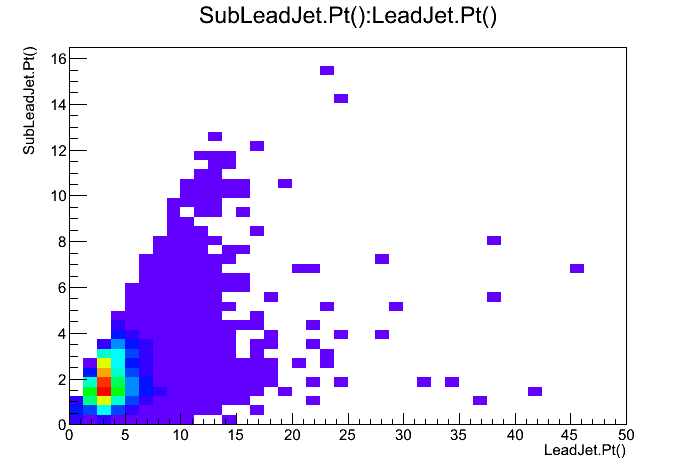Underlying event activity in p+p 200 GeV -- 2015-09-28
Motivation:
How does underlying event multiplicity, average pT change with Leadiing jet pT?
CMS publication: arxiv.org/abs/1507.07229
CDF publication: arxiv.org/abs/1508.05340
Grant Webb's study on p+p 500 GeV data: drupal.star.bnl.gov/STAR/blog/gdwebb/underlying-event-run-9-pp-500-gev
Zilong Change's study on PYTHIA p+p 500 GeV: drupal.star.bnl.gov/STAR/blog/zchang/underlying-event-study-4
Here is Li Yi's first step to study the underlying event in p+p 200 GeV.
See follow-up on mono-jet as direction angle at drupal.star.bnl.gov/STAR/blog/yili/underlying-event-activity-pp-200-gev-mono-jet-2015-10-02-0
See Master Page: drupal.star.bnl.gov/STAR/blog/yili/master-page-underlying-event-pp-200-gev
Data:
p+p 200 GeV
Run 12
filetype=daq_reco_MuDst,events!=0,trgsetupname=pp200_production_2012,filename~st_physics,production=P13ib,storage!=hpss,sanity=1
triggerid: 370541,370542,370351
for BHT0*BBCMB*TOF0, BHT0*BBCMB*TOF0, MTD*BHT3
Cuts:
|Vz|<30 cm
|eta|<1
|dca|< 1 cm
NFIt > 20 points
NFit/NFitPossible > 0.52
Track Pt or Tower Et<1000GeV
no pileup removal
anti-kT algorithm
R = 0.4
ghost area 0.01
Dijet |Δφ-π|<0.4
14M events, found 0.027 M dijet pairs (no jet pT requirement)
Method:
1. Search for dijet pair to define the φdijet = ( φLeading-φSubLeading )/ 2 . Should be φdijet = ( φLeading +(π-φSubLeading ))/ 2.
Both TPC tracks and BEMC towers are used for jet reconstruction by fastjet pacakge.
2. Loop over tracks (charged particles only)
|φ-φdijet|<60 degree --> Leading jet direction
|φ-φdijet|>120 degree --> SubLeading jet direction
60 degree<|φ-φdijet|<120 degree --> transverse direction
For the two transverse directions, the one with larger pT sum of the charged particle is defined as TranMax. The other is TranMin.
3. Sum the multiplciity in various directions.
Calucate the average pT in various directions.
Code:
http://www.star.bnl.gov/cgi-bin/protected/cvsweb.cgi/offline/users/yili/code/run12/underlyingevent/?sortby=rev#dirlist
version 1.1
Result:
1. Leading jet Pt Distribution:

2. SubLeading Jet Pt vs Leading Jet Pt

3. Ntrk in Leading Jet Direction vs Leading Jet Pt
(number of charged particles in |φ-φdijet|<60 degree, including the particles belongs to leading jet) :
4. Sum of charged particle pT in Leading Jet Direction vs Leading Jet Pt. The title in the plot was wrong: it is sum not mean <pT>.
(in |φ-φdijet|<60 degree, including the particles belongs to leading jet) :
5. Ntrk in SubLeading Jet Direction vs Leading Jet Pt
(number of charged particles in |φ-φdijet|>120 degree, including the particles belongs to subleading jet) :
6. Sum of particle pT in recoil side of Jet Direction vs Leading Jet Pt. The title in the plot was wrong: it is sum not mean <pT>.
(in |φ-φdijet|>120 degree, including the particles belongs to subleading jet) :
7. Ntrk in Transverse direction vs Leading Jet Pt
8. <pT> in transverse direction vs Leading Jet Pt
9. Ntrk in TranMax vs Leading Jet Pt
10. <pT> in TranMax vs Leading Jet Pt
11. Ntrk in TranMin vs Leading Jet Pt
12 <pT> in TranMin vs Leading Jet Pt
All the plots show a dip at Leading Jet Pt ~ 12 GeV
How does underlying event multiplicity, average pT change with Leadiing jet pT?
CMS publication: arxiv.org/abs/1507.07229
CDF publication: arxiv.org/abs/1508.05340
Grant Webb's study on p+p 500 GeV data: drupal.star.bnl.gov/STAR/blog/gdwebb/underlying-event-run-9-pp-500-gev
Zilong Change's study on PYTHIA p+p 500 GeV: drupal.star.bnl.gov/STAR/blog/zchang/underlying-event-study-4
Here is Li Yi's first step to study the underlying event in p+p 200 GeV.
See follow-up on mono-jet as direction angle at drupal.star.bnl.gov/STAR/blog/yili/underlying-event-activity-pp-200-gev-mono-jet-2015-10-02-0
See Master Page: drupal.star.bnl.gov/STAR/blog/yili/master-page-underlying-event-pp-200-gev
Data:
p+p 200 GeV
Run 12
filetype=daq_reco_MuDst,events!=0,trgsetupname=pp200_production_2012,filename~st_physics,production=P13ib,storage!=hpss,sanity=1
triggerid: 370541,370542,370351
for BHT0*BBCMB*TOF0, BHT0*BBCMB*TOF0, MTD*BHT3
Cuts:
|Vz|<30 cm
|eta|<1
|dca|< 1 cm
NFIt > 20 points
NFit/NFitPossible > 0.52
Track Pt or Tower Et<1000GeV
no pileup removal
anti-kT algorithm
R = 0.4
ghost area 0.01
Dijet |Δφ-π|<0.4
14M events, found 0.027 M dijet pairs (no jet pT requirement)
Method:
1. Search for dijet pair to define the φdijet = ( φLeading-φSubLeading )/ 2 . Should be φdijet = ( φLeading +(π-φSubLeading ))/ 2.
Both TPC tracks and BEMC towers are used for jet reconstruction by fastjet pacakge.
2. Loop over tracks (charged particles only)
|φ-φdijet|<60 degree --> Leading jet direction
|φ-φdijet|>120 degree --> SubLeading jet direction
60 degree<|φ-φdijet|<120 degree --> transverse direction
For the two transverse directions, the one with larger pT sum of the charged particle is defined as TranMax. The other is TranMin.
3. Sum the multiplciity in various directions.
Calucate the average pT in various directions.
Code:
http://www.star.bnl.gov/cgi-bin/protected/cvsweb.cgi/offline/users/yili/code/run12/underlyingevent/?sortby=rev#dirlist
version 1.1
Result:
1. Leading jet Pt Distribution:

2. SubLeading Jet Pt vs Leading Jet Pt

3. Ntrk in Leading Jet Direction vs Leading Jet Pt
(number of charged particles in |φ-φdijet|<60 degree, including the particles belongs to leading jet) :
4. Sum of charged particle pT in Leading Jet Direction vs Leading Jet Pt. The title in the plot was wrong: it is sum not mean <pT>.
(in |φ-φdijet|<60 degree, including the particles belongs to leading jet) :
5. Ntrk in SubLeading Jet Direction vs Leading Jet Pt
(number of charged particles in |φ-φdijet|>120 degree, including the particles belongs to subleading jet) :
6. Sum of particle pT in recoil side of Jet Direction vs Leading Jet Pt. The title in the plot was wrong: it is sum not mean <pT>.
(in |φ-φdijet|>120 degree, including the particles belongs to subleading jet) :
7. Ntrk in Transverse direction vs Leading Jet Pt
8. <pT> in transverse direction vs Leading Jet Pt
9. Ntrk in TranMax vs Leading Jet Pt
10. <pT> in TranMax vs Leading Jet Pt
11. Ntrk in TranMin vs Leading Jet Pt
12 <pT> in TranMin vs Leading Jet Pt
All the plots show a dip at Leading Jet Pt ~ 12 GeV
Groups:
- yili's blog
- Login or register to post comments
